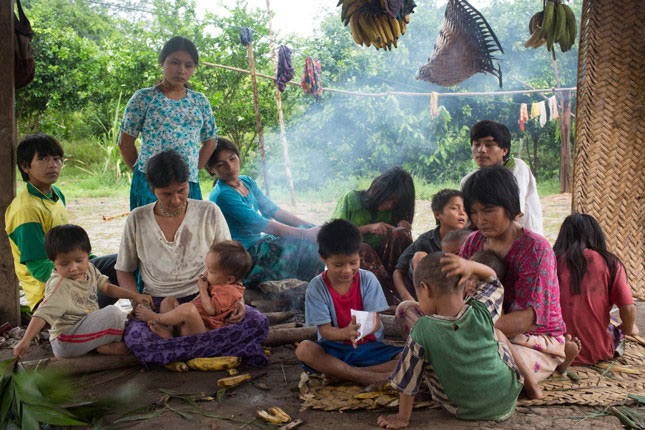The Amazon tribe has the healthiest heart in the world
While the world is facing a wave of emerging cardiovascular diseases, the people of the Tsimane tribe living along the Amazon River in Bolivia never have to worry about the disease.
The Tsimane people began to receive the attention of the whole world after being ranked as the world's most healthy hearts, thanks to a healthy diet containing starchy foods.
People of Tsimane walk, ride bicycles and canoes everywhere. Their main food is self-grown rice, bananas and corn. If they want to eat meat, they just need to go into the forest and hunt animals themselves. In particular, Tsimane people are not interested in modern technology of the outside world.

Tsimane people live in self-built tents in the old forest, away from modern life.(Source: Getty).
According to research published in the British medical journal The Lancet, an 80-year-old Tsimane has a cardiovascular equivalent to an American man in his 50s.
'Tsimane, a community of horticulture and hunting professionals in the Amazon forest in Bolivia, has the lowest incidence of cardiovascular diseases among all the world's communities' - reported in The Lancet. , adding that they also sent the report to the American Heart Institute for further research. According to scientists, it is difficult to find a Tsimane person suffering from a cardiovascular disease. Most people of Tsimane live their entire life without problems with atherosclerosis . No studies have ever documented atherosclerosis in the Tsimane community.
Currently, with a population of about 16,000 people - not really a tribe - Tsimane people still maintain a traditional lifestyle left by their ancestors. They do not use electricity, tap water, but rely entirely on the surrounding environment. Every time they need food, they go to the forest to hunt or develop their own animals for meat.
Last year, some scientists went to the Tsimane community to study about 700 people, capture the cardiovascular system, test cholesterol and blood sugar, measure blood pressure and check for swelling and inflammation . Scientists are particularly interested in the amount of calcium in the blood vessels - a factor to detect fat deposits that accumulate in blood vessel walls. It is known that all of these factors are related to cases of heart failure or stroke.
The results that scientists gained were unexpected: 85% of participants showed no signs of fat accumulation in the walls of blood vessels. Men of Tsimane have even lower coronary artery calcium levels than Japanese women - the part that has previously been recognized as having the world's lowest coronary artery calcium index.

Their diet consists of fish, wild meat, fruits and nuts . (Source: Getty).
This shows that people in the Tsimane community - those who do not use processed food and are constantly moving all day - have the lowest rate of cardiovascular disease in the world. And research published by the scientific community only helps prove that fact.
The members of the Tsimane tribe often live in self-built tents inside the old jungle in Bolivia. The Tsimane people still maintain the traditional lifestyle based mainly on harvesting rice, corn, and bananas from compact lands . They also collect nuts and forest fruits in the Amazon jungle. In order to have a source of animal meat, they often hunt monkeys and wild pigs, in addition to catfish in the region's rivers and streams to eat.
More specifically, in the diet of Tsimane people, about 17% are wild boar, tapir and South American guinea pig (capybara) - the world's largest rodent. In addition, 7% are freshwater fish, including tiger fish (piranha) and catfish. The majority of the remaining food comes from the agricultural products that they cultivate themselves: rice, corn, yam roots (almost like potatoes) and cinnabar.Tsimane people love to eat fruits and nuts.
While people living in the city rarely move in half a day after waking up, the Tsimane people only stop working for about 10% of the entire day. Tsimane men spend an average of 6-7 hours a day to participate in physical activities, while women operate for about 4-6 hours a day - according to research published in The Lancet.
More specifically about the physical activity of the Tsimane people, most of us are encouraged to walk about 10,000 steps daily. However, in the Tsimane community, even people in their 60s walk an average of 16,000 steps a day. According to Dr. Gregory Thomas, one of the researchers from Long Beach Memorial Medical Center in California (USA), the Tsimane community is so active that it is 'incredible'.
- Why do the Tsimane people in Amazon have the healthiest heart on the planet?
- What do you know about the Amazon female tribe that are causing storms in theaters?
- The video rarely shows the original tribal people in the Amazon forest
- Immutable life through 20,000 years of the Amazon forest tribe
- Discover an isolated tribe with the world in the Amazon forest
- The primitive life of tribes in the Amazon forest
- The tribe is close to the monkey with six fingers, swinging the tree as well as Tarzan
- The nearly extinct tribe was discovered in the Amazon forest
- Strange tribe where men wear skirts to rob their wives and beauty pageants
- Terrible mysteries in the Amazon jungle
- Close up of the life of the original Aboriginal people
- Legendary female warriors in the Black Continent
 'Fine laughs' - Scary and painful torture in ancient times
'Fine laughs' - Scary and painful torture in ancient times The sequence of numbers 142857 of the Egyptian pyramids is known as the strangest number in the world - Why?
The sequence of numbers 142857 of the Egyptian pyramids is known as the strangest number in the world - Why? History of the iron
History of the iron What is alum?
What is alum?